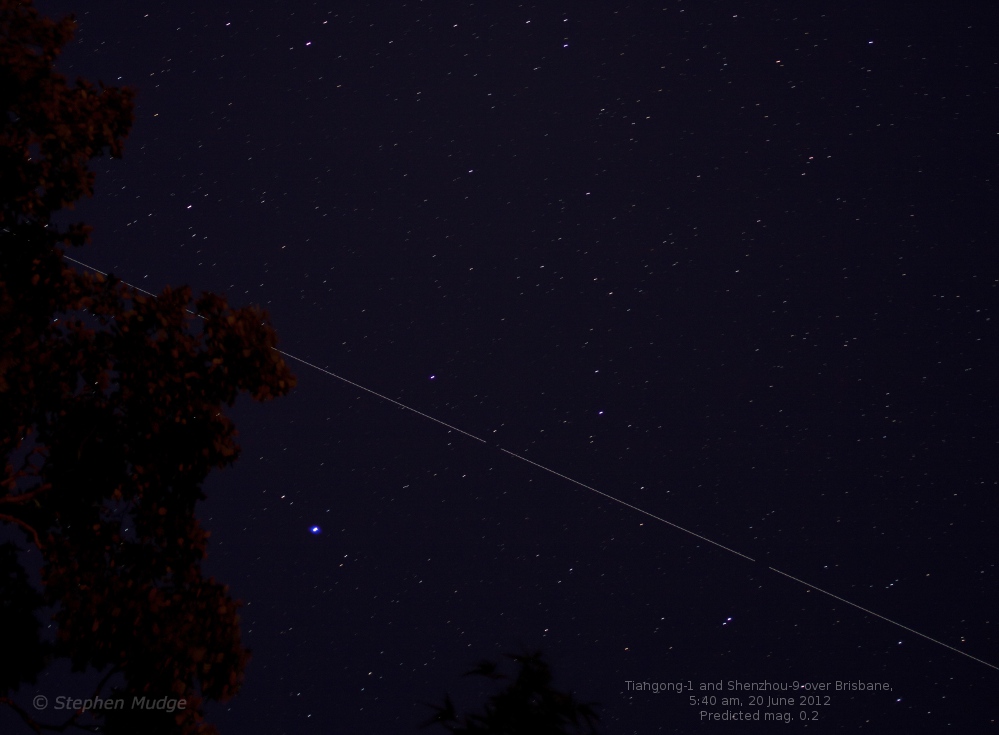Chinese Spacecraft Spotted in Night Sky by Photographers

Last week, Chinese astronauts docked two spacecraft together in orbit for the first, and now skywatchers on the ground have captured the scene.
Chinese spaceflyers Liu Yang, Jing Haipeng and Liu Wang launched June 16 on the Shenzhou 9 spacecraft. Two days later, on June 18, the astronauts (known as taikonauts), docked their vehicle at the robotic Tiangong 1 module, which had been in orbit since last autumn.
The two craft have been orbiting Earth together since, with the astronauts — including China's first female spaceflyer — living and working onboard. From the ground, the docked Chinese vehicles look much like many other satellites, appearing as a swift-moving pinpoint of light passing across the sky.
Astrophotographer Stephen Mudge photographed Shenzhou 9 and Tiangong 1 moving roughly 250 miles (400 kilometers) above Brisbane, Australia on June 20. His long-exposure photo shows the docked spacecraft as a bright streak across the otherwise static sky seen in the early morning hours. [How to See China's Shenzhou 6 in Night Sky]
Mudge had shot one of the Chinese spacecraft before. On March 31, before the Shenzhou 9 mission launched, the skywatcher caught a view of Tiangong 1 crossing overhead just five minutes apart from a pass of the International Space Station (ISS).
"The ISS went over first, followed five minutes later by China's Tiangong 1 station only a few degrees away from where the ISS had been," Mudge wrote in an email to SPACE.com.

The International Space Station is the $100 billion product of a collaboration between the United States, Russia, Europe, Japan and Canada. Tiangong 1 is much smaller, but it is the prototype module for China's goal of establishing a space station of its own by 2020.
Get the Space.com Newsletter
Breaking space news, the latest updates on rocket launches, skywatching events and more!
The ISS is the brightest man-made object in the sky. In comparison, Tiangong 1 is clearly fainter in the photo. Nonetheless, both are plainly visible against a backdrop of trees and purple sky in Mudge's photo.
The Shenzhou 9 crew is scheduled to remain in orbit for a total of 13 days, meaning time is running out for skywatchers to catch a glimpse of the history-making mission.
To find out whether the Chinese spacecraft will be visible from your area, check out these three websites, which list suggested spotting times based on your zip code or city. The predictions should be accurate to within a few minutes, and would-be viewers would do well to check back often for updates:
Another great resource is the website Real Time Satellite Tracking, which shows the variety of spacecraft that will be flying over any given region at any time.
Editor's note: If you snap amazing photos of China's Shenzhou 9 capsule or Tiangong 1 module in orbit that you'd like to be considered for use in a story or gallery, please send pictures and comments to SPACE.com managing editor Tariq Malik at tmalik@space.com.
Follow Clara Moskowitz on Twitter @ClaraMoskowitz or SPACE.com @Spacedotcom. We're also on Facebook & Google+.
Join our Space Forums to keep talking space on the latest missions, night sky and more! And if you have a news tip, correction or comment, let us know at: community@space.com.

Clara Moskowitz is a science and space writer who joined the Space.com team in 2008 and served as Assistant Managing Editor from 2011 to 2013. Clara has a bachelor's degree in astronomy and physics from Wesleyan University, and a graduate certificate in science writing from the University of California, Santa Cruz. She covers everything from astronomy to human spaceflight and once aced a NASTAR suborbital spaceflight training program for space missions. Clara is currently Associate Editor of Scientific American. To see her latest project is, follow Clara on Twitter.












